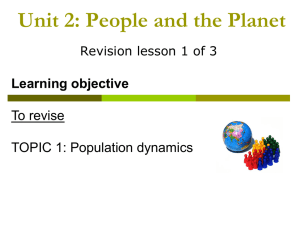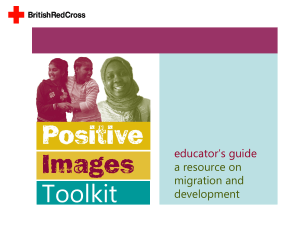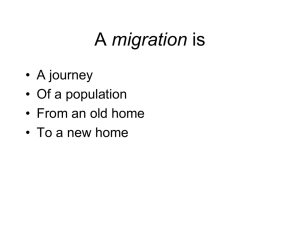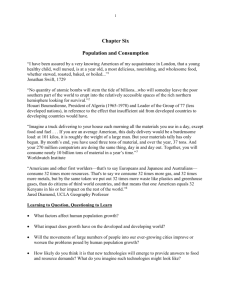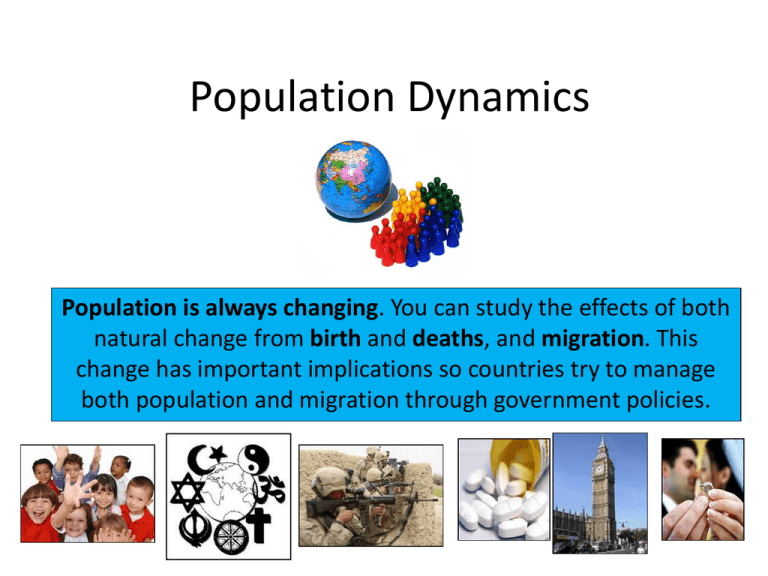
Population Dynamics
Population is always changing. You can study the effects of both
natural change from birth and deaths, and migration. This
change has important implications so countries try to manage
both population and migration through government policies.
You need to know:
1.1 How and why population is changing in
different parts of the world?
1.2 How far can population change and
migration be managed sustainably?
Key terms:
Key term
Definition
Ageing Population
This is when a country has a large number of people over the
age of 65 in their country.
Anti – natalist policy
A government policy used to encourage people to have fewer
children.
Birth rate
The number of births per 1,000 people in a year.
Death rate
The number of deaths per 1,000 people in a year.
Development
Economic and social progress that leads to improvements in the
quality of life for an increasing proportion of the population.
Economic migrant
Someone who has emigrated from one region to another region
looking for employment or improved standard of living.
Emigrant
A person leaving a country or region to live somewhere else (for
at least one year).
Exponential Growth
When the population starts doubling itself very quickly - the
bigger the population the faster it grows
Key term
Definition
Fertility rate
The average number of children born to a woman in her lifetime.
Immigrant
A person arriving in a country or region to live (for at least one
year).
Infant mortality rate
The number of babies who die per 1, 000 before the child's first
birthday.
Life expectancy
The average number of years a person might be expected to live.
Migration
The movement by people from one place to another
Natural change
The change (an increase or a decrease) in population numbers
resulting from the difference between birth and death rates.
Natural increase
Is the number of people added to or lost from the population of
every 1000 people in one year.
Overpopulation
An area that has too many people for the resources available.
Key term
Definition
Population pyramid
A diagrammatic way of showing the age and sex structure of a
population.
Population structure
The 'make up' or composition of a population
Pro -natalist policy
A government policy used to encourage people to have more
children.
Tipping point
The point at which the momentum of a change is unstoppable.
Under population
When there are too few people to develop fully the economic
potential of an area or nation.
Youthful population
This is when there are a very high percentage of people under
the age of 15.
Zero population
growth
(also called the replacement level, is where the population
neither grows or declines, and remains stable.
Key idea 1: What has happened to the global
population – historical, current and future trends?
•
•
•
•
•
The world population is growing at an alarming rate in 2013 at least another
65 million people were added to the global total of 7.1 billion.
Exponential Growth has been occurring (In 2000 the doubling time fell to 39
years)
Watch this YouTube video on population growth and future projections.
http://www.youtube.com/watch?v=fTznEIZRkLg&feature=related&safe=active
However since 2000 the rate of growth has become more uncertain in fact no
country in the EU is producing enough babies to stop their population
declining.
Key idea 2: Why does natural increase vary
around the world?
Could be due to a decline in death rates and infant mortality rates:
• Development of modern medicines and Introduction of vaccination and immunisation programmes
e.g. smallpox vaccination that helps people to live longer.
• Cleaner drinking water and better sewage disposal, a lot more people have access to clean drinking
water than before.
• Better healthcare – more doctors, nurses and hospitals, means that people can be treated and not
die.
• Better diets, e.g. promoting eating ‘5 a day
• Changing social conditions – attitudes to marriage etc.
• Technology might facilitate population growth - improved fertility treatment
However death rates might also be unpredictable because:
• Catastrophes might occur such as natural disasters
•
Resources might run out causing famine/wars etc
• Pandemics might occur - HIV/AIDS
Key Idea 3. How and why does the population of a country
change? - The Demographic Transition Model
Stage 1: High fluctuating – E.g. a few remote tribes
- High birth rate due to no birth control and high infant mortality
- High death rate due to disease and famine
Stage 2: Early expanding – E.g. Niger, Bangladesh
- High birth rate
- Falling death rates due to improved health care and nutrition
Stage 3: Late expanding – E.g. India, Brazil & Mexico
- Falling birth rates due to birth control and wanting smaller families
- Falling death rates
Stage 4: Low fluctuating E.g. USA, France
- Low birth and death rates due to working women delaying age to start their families
Stage 5: Decline E.g. Japan & Russia
- Death rate higher than birth rate due to a ‘grey’ population
As with any theory or model, The DTM isn’t without its
critics though!
It is a
generalisation.
Not all countries
have followed the
same path of
development or
growth.
Some countries
develop at faster
speeds than
others.
Migration isn’t taken into
account.
And to help you remember here is the DTM song:
http://www.youtube.com/watch?v=pzxREH08EkI
Key Idea 4: Why are their variations in population
structure around the world? (Population Pyramids)
Population pyramids show important features
of a population – age and gender.
This diagram below shows how to read one.
Population pyramids can be seen to link to the
Demographic Transition Model – this is what they look
like at different stages of the DTM.
MEDC like Russia
1.
2.
3.
4.
The birth rate in an MEDC is DECLINING
The birth rate is higher in a LESS DEVELOPED country.
The death rate is lower in an MORE DEVELOPED country.
Females generally live LONGER than males in both countries.
LEDC like Yemen
Named study 1: Comparing the growth rates of Russia & Yemen
RUSSIA
(MEDC)
YEMEN
(LEDC)
Current Population
142 million
24.7 million
GNI Per Person
Upper middle income country
($10,400)
Lower middle income country
($ 1,070)
Birth Rate
12.3
32.6
Death Rate
14.1
6.8
Natural Increase
-0.2
2.6
Predicted Population in 2057
Fall to 104 million
Rise to 105 million
Reasons for…
Population decline...
Falling life expectancy caused by
industrial disease and alcoholism
Outward migration of young men and
women
A low fertility rate of 1.2
Population growth....
Early age of marriage (48% of women
are married before the age of 18)
Low literacy rates among women
A high fertility rate of 6.7 children due
to improved life expectancy and child
vaccines
Key Idea 5: What are the issues relating to a youthful
or ageing population?
Youthful population - This is when there are a very high percentage of people under the age of 15.
Problems:
•Pressure on housing – not enough housing, people living in slums. This is very common around the big cities (New Delhi),
where millions of people live in shanty towns with no running water, roads, sewage of any kind.
•Pressure on schooling – illiterate population. India’s literacy rate is 60%, Cambodia’s literacy rate is 69%
•Pressure on food supplies - famine, food distribution difficulties. Natural disasters accentuate this problem e.g. droughts.
•Pressure on health services – a growth in diseases being spread around and not being dealt with adequately to stop the
spread.
•High unemployment - Large numbers of people unable to find work so they emigrate
Ageing population
This is when a country has a large number of people over the age of 65 in their country.
Problems:
•Health care
•Skilled health care workers, e.g. nurses, doctors, etc.
•Pensions - Increase in pension costs.
•More retired people means fewer workers in the economy
3 solutions
–Increase tax – not popular
–Raise retirement age – not popular
–Abolish state pensions – not popular
Watch this clip on why the UK’s
population is ageing
http://www.bbc.co.uk/lear
ningzone/clips/why-is-theuks-populationageing/537.html
Named study 2: Countries with contrasting
population structures Japan vs. Mexico
Youthful population: Mexico (LEDC)
Facts
- 31% of population under 15
- Population grew 50 million in
40 years
- Average age in 26
Causes
- Low death rate at 4.78 deaths
per 1000. due to vaccinations
and doctors
- falling birth rate but large % of
young people
- Will take 50 years for to loose
it’s youthful population
Effects
- Increase need for school places
- Young people unable to find
work so emigrate to
- Growing manufacturing
industry
- Strongly catholic but abortion
has been legalised to reduce
number of children
Ageing Population – Japan (MEDC)
Facts
- 20.8% of population aged +65
- 26.8 million pensioners
- Birth rate below replacement
level
Causes
- People living longer (79 for
men & 85 for women). Due to
healthy diet and high GDP
- Birth rate declining due to
increase age of first child (2006
29.2 years) and number of
marriages has decreased
Effects
- Increase cost of pensions as
fewer workers
- Government raised retirement
age from 60 to 65
- Increase in numbers in nursing
homes
- Increase cost of medical care
Key Idea 6: Why do some countries wish
to control their population?
Named study 3: Pro - Natalist Policy – Singapore (More, More, More)
What?
Marriage and Parenthood
package - Launched in 2008
Why?
- Concerns about an ageing
population more pressure on
working population.
Helps people to find life
- Concerns that there are not
partners
enough people of working age Provides housing schemes to
Not enough money collected in
help couples set up a home
tax to pay for public services
Offers baby bonus schemes
- Small population - only
Offers maternity leave 16 weeks 5million means more pressure
Provides paid child care leave
on military and other services
for working parents.
Offers state subsidised child
care.
Watch these clips to help you understand their policy:
http://www.youtube.com/watch?v=Qz8PTkjJuqo
http://www.youtube.com/watch?v=mltkqqaGFUE
Effects
Increased fertility rate
Named study 4: Anti - natalist Policy – China (one child policy)
What?
Why?
•Introduced in 1970s – couples not -High growth rate of population
allowed to have more than one
- Pressure on land and food
child.
supplies due to large population
•Couples with one child were given
benefits e.g. cash bonuses, better
childcare and improved housing.
•Unauthorised pregnancies
pressured to have abortions
•Men have to be over 22 and
women over 20 in order to be
granted permission to have a child
•State officials with more than one
child lose their job and other rule
breakers receive a heavy fine
•Families in rural areas are allowed
2 children
Watch these clips to help you understand their policy:
https://www.youtube.com/watch?v=V0cQIlHlKxM
http://www.bbc.co.uk/news/world-asia-china19677676
Effects
-Birth rate fell from 34 per 1000 in
1970 to 13 per 1000 in 2008
- Annual population growth rate
fell from 2.4% to 0.6%
-Total population grown from 996
million in 1980 to 1,320 million
today
-Chinese tradition to prefer sons so
sex selective abortions occurred
(120 males to 100 females)
-Shortage of women at marrying
age - China faces population in
balance crisis
-High % of unwanted babat girls
abandoned or left in orphanages
-Concerns that now China will not
have enough workers for its rapidly
growing economy
-Concerns that there will not be
babies people of working age to
support china’s ageing population
(4 grandparents, 2 parents and 1
child)
Key idea 7: Why do People Migrate?
There are many different reasons why people migrate. These
factors can be spilt into two categories: PUSH FACTORS and PULL
FACTORS.
Factors which cause someone to leave an
area, i.e. they PUSH people out. Also known
as forced migration.
Factors which attract someone to an area, i.e.
they PULL people in. Also known as voluntary
migration.
Named Example 5: Migration policies in the UK
Source advantages (the country they have come
from)
UK advantages
Immigrants send money to their home countries
(remittance)
Immigrants take skills back to their home country
when they leave the UK.
Less pressure on jobs in countries like Bangladesh
and Poland
Migrants are often young, helping to solve the
problem of an ageing population in the UK
Immigrants can often take low paid jobs which
people in the UK are unwilling to do
Increases cultural diversity in the UK
Addresses the problem of skilled and unskilled
labour shortages
Less then 5% of immigrants claim any sort of state
benefits
Immigrants contribute to the economy by paying
taxes
Source disadvantages
UK disadvantages
Decline in birth rate as most migrants are young
men
Loss of working population
Some immigrants can remain isolated and not
integrate with the wider community. Can lead to
hostility and stereotyping
Local people can find it difficult to find jobs in the
crowded labour market
Public money needs to be spent on extra housing
and healthcare to cope with the increase in
population
Which policy is best for the UK?
Open-door policy :
Post War immigrants came to UK from colonies in the Caribbean due to an Act of Parliament giving all
Commonwealth (ex-colonial) citizens free entry into the UK. (1950-1960s ¼ million people came from the Caribbean).
Another example of an open door policy is membership of the EU which allows all members of the EU to move freely
between each country this was particularly evident when in 2004 eastern European countries of Czech Republic,
Estonia, Hungary, Poland, Latvia, Lithuania, Slovakia and Slovenia joined the EU (A8 – Accession countries). This
meant that citizens of these countries are free to move and work in other EU member countries. In most cases these
economic migrants stay only until they feel they have made enough money to take home
https://www.youtube.com/watch?v=p_fv3HpSFww
Advantages:
Meets shortage of unskilled and semi-skilled labour
Helped with the reconstruction of the country post war
Fill jobs that British citizen are reluctant to do.
Can provide economic boost – It is estimated that Polish
people have contributed more than three times as much
to the UK economy than they have cost.
Disadvantages
Public money spent on meeting needs of the immigrants
e.g. housing etc
Recession – immigrants can lead to increased
unemployment
Wages are forced down because migrants are willing to
work for less
Can lead to ethnic tensions
Points-based system – A skills tested policy is when tests are used to assess the qualifications and
skills that potential immigrants have to see if they match the jobs and skills that are needed in a country. The UK
points based system was established in 2008 and contains 5 tiers of migrants. Tier one has highly skilled workers
such as scientists, down to Tier five who are temporary workers e.g. musicians playing in a concert.
http://www.youtube.com/watch?v=2wfPNp6bIRw – watch this advert to help you understand the different tiers.
Immigration quotas - In the UK, there are quotas in place, working alongside the Points-based system.
For example, only 20,700 people from tier 2 are allowed access to migrate to the UK each year (from outside the EU).
http://migrationobservatory.ox.ac.uk/policy-primers/migrants-london-policy-challenges
One of the most extreme examples was the US Immigration Act of 1924, where they limited the number of migrants
from each country to 2% of the total number from that country who were already living in the USA. For example, if
there were 1 million Indian people living in the USA in 1925, the maximum number of Indian people who could
migrate to the USA in that year would be 20,000. Advantages:
•
Migrants contribute to the UK economy by paying
tax.
•
Many jobs they do are low paid. These are jobs
often avoided by UK workers.
•
Strong work-ethic. Efficient and polite.
•
Less than 5% receive any state benefit.
•
Stops too many people migrating into the UK.
•
Can be changed according to what the country
needs
Disadvantages:
•
restricts well qualified people from coming into the
country.
•
Restrict movement of people fleeing persecution.
Key Idea 8: Tensions that arise as a result of migration
The UK immigration of ethnic groups lead to conflict as there was hostility towards them. These ethnic
groups banded together into particular areas to reduce the risk of being victimised. The UK government
stepped in and stated that all citizens regardless of ethnicity should enjoy equal opportunities. Today much
more harmonious as people have begun to realise the positives of having them; they add to country’s skill
base and culture.
Population Dynamics – past questions
Explain why the future growth rate of the world’s population is hard to predict. (4)
Suggest TWO reasons why some developing countries have high birth rates. (2)
Describe what is meant by an ‘ageing population’. (2)
Suggest two reasons why some countries have large numbers of elderly people. (2)
Explain why people in many developed countries are living a lot longer now. (2)
Give two reasons why a country may have an ageing population. (2)
Describe two economic impacts of an ageing population. (2)
Outline either one social or one economic issue resulting from an ageing population. (2)
Explain TWO problems faced by countries with ageing populations. (4)
Many countries have youthful populations. Describe what is meant be a ‘youthful population’ (2) New
Outline two problems faced by countries with youthful populations (4) New
Suggest two reasons why many countries have experienced a fall in birth rate. (2)
Suggest two reasons why some European countries have falling populations. (2)
Name a country that has an anti-natal policy. (1)
Describe one policy used to control population size in a country. (2)
Describe the methods governments can use to control population size. (4)
Using examples, describe how a government might try to encourage fewer births (an anti-natalist policy). (4)
Explain why some governments may wish to control their population size. (2)
Explain why some governments may wish to control their population size. (2)
Explain why governments may wish to control the number of migrants entering their country. (2)
Explain why some countries decide to reduce levels of immigration (4) New
Using named examples, explain why some countries choose to increase immigration but others choose to reduce it (4) New
Using named examples explain why predicting the future population size of countries is difficult (6) New
Population Dynamics
Good Luck

